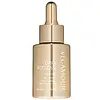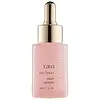What's inside
What's inside
 Key Ingredients
Key Ingredients

 Benefits
Benefits

 Concerns
Concerns

 Ingredients Side-by-side
Ingredients Side-by-side

Water
Skin ConditioningPropanediol
SolventGlycerin
HumectantPentylene Glycol
Skin ConditioningAlcohol Denat.
AntimicrobialPolyglyceryl-10 Laurate
Skin ConditioningNiacinamide
SmoothingCaffeine
Skin ConditioningPalmitoyl Tetrapeptide-20
AntioxidantAcetyl Hexapeptide-1
Skin ConditioningCalcium Pantothenate
Sodium Ascorbyl Phosphate
AntioxidantPyridoxine Hcl
Skin ConditioningTocopheryl Acetate
AntioxidantPolygonum Multiflorum Root Extract
Skin ConditioningZinc PCA
HumectantMaltodextrin
AbsorbentSodium Starch Octenylsuccinate
AbsorbentCitrus Bergamia Peel Oil Expressed
PerfumingGlycine Soja Seed Extract
Skin ConditioningLimonene
PerfumingLinalool
PerfumingCitric Acid
BufferingCitral
PerfumingSilica
AbrasiveDextran
Glycoproteins
Skin ConditioningWater, Propanediol, Glycerin, Pentylene Glycol, Alcohol Denat., Polyglyceryl-10 Laurate, Niacinamide, Caffeine, Palmitoyl Tetrapeptide-20, Acetyl Hexapeptide-1, Calcium Pantothenate, Sodium Ascorbyl Phosphate, Pyridoxine Hcl, Tocopheryl Acetate, Polygonum Multiflorum Root Extract, Zinc PCA, Maltodextrin, Sodium Starch Octenylsuccinate, Citrus Bergamia Peel Oil Expressed, Glycine Soja Seed Extract, Limonene, Linalool, Citric Acid, Citral, Silica, Dextran, Glycoproteins
Water
Skin ConditioningButylene Glycol
HumectantGlycerin
HumectantAlcohol Denat.
AntimicrobialPolyglyceryl-10 Laurate
Skin ConditioningCaffeine
Skin ConditioningCurcuma Longa Callus Conditioned Media
Skin ConditioningCitrus Bergamia Peel Oil Expressed
PerfumingSodium Phytate
Pentylene Glycol
Skin ConditioningLimonene
PerfumingCitric Acid
BufferingSodium Benzoate
MaskingPotassium Sorbate
PreservativeLactic Acid
BufferingTrifolium Pratense/Vigna Radiata) Sprout Extract
AntioxidantLinalool
PerfumingSodium Hydroxide
BufferingBiotin
AntiseborrhoeicAlcohol
AntimicrobialPhytic Acid
Linalyl Acetate
MaskingPinene
MaskingNicotiana Benthamiana Octapeptide-30 Sh-Oligopeptide-2
Skin ConditioningNicotiana Benthamiana Hexapeptide-40 Sh-Polypeptide-9
Nicotiana Benthamiana Hexapeptide-40 Sh-Polypeptide-86
Water, Butylene Glycol, Glycerin, Alcohol Denat., Polyglyceryl-10 Laurate, Caffeine, Curcuma Longa Callus Conditioned Media, Citrus Bergamia Peel Oil Expressed, Sodium Phytate, Pentylene Glycol, Limonene, Citric Acid, Sodium Benzoate, Potassium Sorbate, Lactic Acid, Trifolium Pratense/Vigna Radiata) Sprout Extract, Linalool, Sodium Hydroxide, Biotin, Alcohol, Phytic Acid, Linalyl Acetate, Pinene, Nicotiana Benthamiana Octapeptide-30 Sh-Oligopeptide-2, Nicotiana Benthamiana Hexapeptide-40 Sh-Polypeptide-9, Nicotiana Benthamiana Hexapeptide-40 Sh-Polypeptide-86
Alternatives
Ingredients Explained
These ingredients are found in both products.
Ingredients higher up in an ingredient list are typically present in a larger amount.
Alcohol Denat. is an alcohol with a denaturant property. It is created by mixing ethanol with other additives.
This ingredient gets a bad rep because it is irritating and drying - mostly due to its astringent property. Astringents draw out natural oils in tissue, constricting pores and leaving your skin dried out.
However, alcohol denat. is not all that bad.
Due to its low molecular weight, alcohol denat. tends to evaporate quickly. One study on pig skin found half of applied alcohol evaporated in 10 seconds and less than 3% stayed on skin.
This also helps other ingredients become better absorbed upon application.
Studies are conflicted about whether this ingredient causes skin dehydration. One study from 2005 found adding emollients to propanol-based sanitizer decreased skin dryness and irritation. Another study found irritation only occurs if your skin is already damaged.
Small amounts of alcohol are generally tolerated by oily skin or people who live in humid environments.
The rule of thumb is if this alcohol is near the end of an ingredients list, it will probably not affect your skin much.
Also...
This ingredient has antimicrobial and solvent properties.
The antimicrobial property helps preserve products and increase their shelf life. As a solvent, it helps dissolve other ingredients.
Other types of astringent alcohols include:
Learn more about Alcohol Denat.Caffeine is most associated with coffee, tea, and cacao. In skincare, it helps with calming inflammation and is rich in antioxidants.
While caffeine is used to treat cellulite and and dark circles, further studies are needed to prove this. It has been believed to help with these skin conditions due to its ability to dilate blood vessels and increase blood flow.
Some studies are looking into caffeine's ability to protect against UV rays.
Learn more about CaffeineCitric Acid is an alpha hydroxy acid (AHA) naturally found in citrus fruits like oranges, lemons, and limes.
Like other AHAs, citric acid can exfoliate skin by breaking down the bonds that hold dead skin cells together. This helps reveal smoother and brighter skin underneath.
However, this exfoliating effect only happens at high concentrations (20%) which can be hard to find in cosmetic products.
Due to this, citric acid is usually included in small amounts as a pH adjuster. This helps keep products slightly more acidic and compatible with skin's natural pH.
In skincare formulas, citric acid can:
While it can provide some skin benefits, research shows lactic acid and glycolic acid are generally more effective and less irritating exfoliants.
Most citric acid used in skincare today is made by fermenting sugars (usually from molasses). This synthetic version is identical to the natural citrus form but easier to stabilize and use in formulations.
Read more about some other popular AHA's here:
Learn more about Citric AcidCitrus Bergamia Peel Oil Expressed is a fragrance and is an oil.
Glycerin is already naturally found in your skin. It helps moisturize and protect your skin.
A study from 2016 found glycerin to be more effective as a humectant than AHAs and hyaluronic acid.
As a humectant, it helps the skin stay hydrated by pulling moisture to your skin. The low molecular weight of glycerin allows it to pull moisture into the deeper layers of your skin.
Hydrated skin improves your skin barrier; Your skin barrier helps protect against irritants and bacteria.
Glycerin has also been found to have antimicrobial and antiviral properties. Due to these properties, glycerin is often used in wound and burn treatments.
In cosmetics, glycerin is usually derived from plants such as soybean or palm. However, it can also be sourced from animals, such as tallow or animal fat.
This ingredient is organic, colorless, odorless, and non-toxic.
Glycerin is the name for this ingredient in American English. British English uses Glycerol/Glycerine.
Learn more about GlycerinLimonene is a fragrance that adds scent and taste to a formulation.
It's found in the peel oil of citrus fruits and other plants such as lavender and eucalyptus. The scent of limonene is generally described as "sweet citrus".
Limonene acts as an antioxidant, meaning it helps neutralize free radicals.
When exposed to air, oxidized limonene may sensitize the skin. Because of this, limonene is often avoided by people with sensitive skin.
The term 'fragrance' is not regulated in many countries. In many cases, it is up to the brand to define this term. For instance, many brands choose to label themselves as "fragrance-free" because they are not using synthetic fragrances. However, their products may still contain ingredients such as essential oils that are considered a fragrance.
Learn more about LimoneneLinalool is a fragrance and helps add scent to products. It's derived from common plants such as cinnamon, mint, citrus, and lavender.
Like Limonene, this ingredient oxidizes when exposed to air. Oxidized linalool can cause allergies and skin sensitivity.
This ingredient has a scent that is floral, spicy tropical, and citrus-like.
Learn more about LinaloolPentylene glycol is typically used within a product to thicken it. It also adds a smooth, soft, and moisturizing feel to the product. It is naturally found in plants such as sugar beets.
The hydrophilic trait of Pentylene Glycol makes it a humectant. As a humectant, Pentylene Glycol helps draw moisture from the air to your skin. This can help keep your skin hydrated.
This property also makes Pentylene Glycol a great texture enhancer. It can also help thicken or stabilize a product.
Pentylene Glycol also acts as a mild preservative and helps to keep a product microbe-free.
Some people may experience mild eye and skin irritation from Pentylene Glycol. We always recommend speaking with a professional about using this ingredient in your routine.
Pentylene Glycol has a low molecular weight and is part of the 1,2-glycol family.
Learn more about Pentylene GlycolPolyglyceryl-10 Laurate is an ester of lauric acid and Polyglycerin-10.
Polyglyceryl-10 Laurate is a cleansing agent and emulsifier. It helps gather dirt, oil, and other pollutants to be rinsed away. As an emulsifier, it helps prevent ingredients from separating, such as oil and water.
Polyglyceryl-10 Laurate may not be fungal acne safe.
Learn more about Polyglyceryl-10 LaurateWater. It's the most common cosmetic ingredient of all. You'll usually see it at the top of ingredient lists, meaning that it makes up the largest part of the product.
So why is it so popular? Water most often acts as a solvent - this means that it helps dissolve other ingredients into the formulation.
You'll also recognize water as that liquid we all need to stay alive. If you see this, drink a glass of water. Stay hydrated!
Learn more about Water